Measures of Leakages of Aluminum Die Castings (Part Two)
2.2 Optimizing the structure of the mold or product
After processing a cylinder block, it is found that there are large shrinkage holes in the bolt holes near the water channel (Figure 3). At the same time, when the 100% leak test is performed for the product, the leakage rate of the water channel is relatively high. Appearance inspection and CT scan of the defective products found that there were slight strains on the inner wall of the water channel and internal shrinkage holes penetrated, resulting in leakages. After analyzing the product, it is found that the wall thickness at this position is great, and shrinkage holes are easily formed inside. Since this position needs to be machined, a mold core can be provided to the mold to form a pre-cast hole, thereby reducing the wall thickness, which is conducive to the cooling of the casting. At the same time, the surface of the mold core is covered, which facilitates the adhesion of the release agent, and fundamentally avoids the generation of shrinkage cavities and the surface strain of the pre-casting holes.
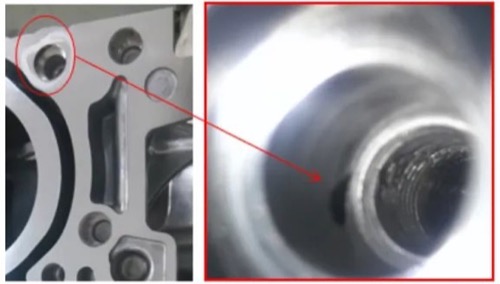
Figure 3 Pre-cast holes improving the shrinkage holes
The product design and subsequent mold design cannot be perfect, and the actual casting process cannot be simulated due to the limitation of boundary condition settings. Therefore, many defects are difficult to be completely prevented in product design, and the problem occurs often in the mass production process. However, the product or mold can be properly optimized without affecting the structure and function of the final product.
Providing pre-cast holes is a common solution to solve shrinkage holes, but when providing pre-cast holes, it is necessary to focus on the diameter, depth and position of the holes, and control of the draft angle. Once the mold core is deformed, it must be replaced. The surface of the core should be treated to increase its strength.
For mold sticking and strain, it is mainly concentrated on some protrusions with high mold temperature (corresponding parts are grooves) and positions with small drafting angle and the areas where the molten aluminum is directly scoured. When the mold is opened, the mold pulls the surface of the part. Therefore, on the premise of not affecting the wall thickness, the rounded corners of the convex position of the mold can be appropriately increased, and the draft angle can be appropriately increased, or the surface of the mold can be coated to make the mold release agent more attached to the surface of the mold to reduce the risk of strain and mold sticking.
2.3 Formulating process plans
A certain cylinder block leaked during the engine test, and the leakage point was the threaded hole close to the oil passage. CT scanning of the defective parts showed that there was shrinkage porosity at the bottom of the threaded hole, as shown in Figure 4. The pre-cast hole has been provided to this position, but the mold temperature is still high after measuring. Finally, high-pressure spot cooling was provided, and the mold temperature was controlled; the shrinkage cavity was significantly improved, as shown in Figure 5.
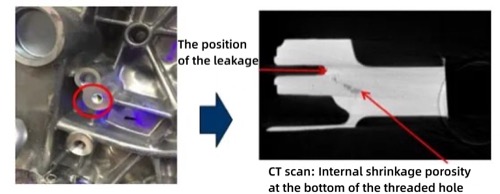
Figure 4 Leakages due to shrinkage porosity at the bottom of the threaded hole
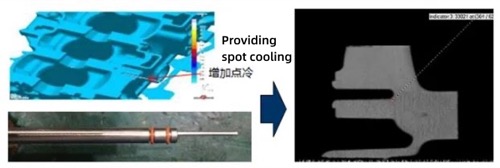
Figure 5 Significantly improved shrinkage cavities with the addition of high-pressure spot cooling
The 100% leakage test was carried out after a certain cylinder block was processed, and it was found that the leakage test rate of the product was high. After statistical analysis of the defective products, it was found that 95% of the products were unqualified in the high-pressure oil passage test. CT scan found that there were many shrinkage porosities at the bottom of the threaded hole of the main bearing seat near the high-pressure oil passage, and the leakage test rate was not significantly improved after adding the pre-cast hole. Subsequently, a partial extrusion process was provided to the main shaft hole (Figure 6) to make the position denser, thereby reducing shrinkage cavities. After verification, the leakage test rate was reduced from 4% to 0.2%, and the effect was obvious.
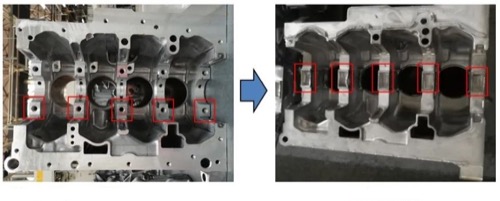
Figure 6 Using partial extrusion to significantly improve the leak test rate at this location
A good process plan also has a great effect on reducing the shrinkage cavity ratio and mold sticking and strain on the casting surface. Sometimes the problem of internal shrinkage holes may not be solved by simply adding pre-cast holes. In this case, it is necessary to use a little cooling, that is, to increase the cooling circulation channel inside the mold or mold core. Spot cooling is divided into ordinary spot cooling and high-pressure spot cooling. The selection of the two still needs to be determined by the mold temperature. If the mold temperature is high, the high-pressure spot cooling can quickly take away the heat. This process scheme is very practical and successful in many die-cast factories. At the same time, it is necessary to check and replace the cold core regularly to avoid other problems such as the deformation of mold cores and leakages.
At present, the partial extrusion process is more and more widely used in the key positions of die castings. The partial extrusion makes the internal casting quality denser, so the proportion of shrinkage cavities and shrinkage porosity is lower. In the partial extrusion process, it is important to control the starting time of extrusion, the spraying of extrusion pins for avoiding blocking extrusion pins, and the depth of extrusion.
In addition to the above solutions, the treatment of mold surfaces, types of cooling water, types of spraying, spraying time, spraying angles, spraying distance and spraying path need to be considered, for example, cooling water. For some castings with higher requirements, many die-cast plants use pure water for cooling to avoid scaling in the cooling channel, thereby reducing the cooling flow and causing the mold temperature to fail to meet the requirements. For the process settings of spraying, profile spraying is now more and more used, and regular calibration of the nozzle position is also necessary. In general, the formulation of process parameters has a great impact on the quality of die castings, which needs to be verified through a large number of tests and experiences, and is also a continuous optimization process.
2.4 Process Control
The main purpose of process control is to ensure that the relevant parameters are stably implemented under the provisions of the established process plan. The monitoring of mold temperature is particularly important. Currently, thermocouples can be used to monitor mold temperature in real time. However, since it cannot cover all locations, it is necessary to use a thermal imager or a temperature measuring gun to measure mold temperature regularly. In addition to the use of thermal imagers for analyzing specific problems, it is very important to carry out continuous temperature measurement during the formulation of mold temperature parameters (Figure 7).
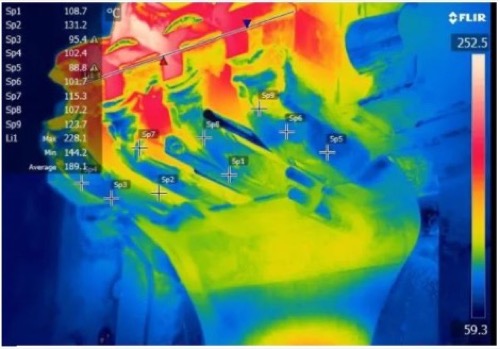
Figure 7 Analyzing and controlling mold temperature by the thermal imager
Many parameters affect the mold temperature. In addition to directly monitoring the mold temperature, it is very important to regularly monitor the cooling water flow, whether the release agent nozzle is blocked, and whether the inserts are regularly cleaned and replaced as required.
3. Conclusion
From the whole process of die-cast production, how to avoid internal shrinkage cavities and surface strain of die-cast parts is summarized. Taking an aluminum die-cast cylinder block as an example, after using this scheme, the failure rate of the leakage test after rough machining in the foundry is reduced to 0.3%, and the failure rate of the leakage test after fine machining in the main engine factory is reduced to 0.2%. No leakage is achieved for 2 consecutive years.
After processing a cylinder block, it is found that there are large shrinkage holes in the bolt holes near the water channel (Figure 3). At the same time, when the 100% leak test is performed for the product, the leakage rate of the water channel is relatively high. Appearance inspection and CT scan of the defective products found that there were slight strains on the inner wall of the water channel and internal shrinkage holes penetrated, resulting in leakages. After analyzing the product, it is found that the wall thickness at this position is great, and shrinkage holes are easily formed inside. Since this position needs to be machined, a mold core can be provided to the mold to form a pre-cast hole, thereby reducing the wall thickness, which is conducive to the cooling of the casting. At the same time, the surface of the mold core is covered, which facilitates the adhesion of the release agent, and fundamentally avoids the generation of shrinkage cavities and the surface strain of the pre-casting holes.

Figure 3 Pre-cast holes improving the shrinkage holes
The product design and subsequent mold design cannot be perfect, and the actual casting process cannot be simulated due to the limitation of boundary condition settings. Therefore, many defects are difficult to be completely prevented in product design, and the problem occurs often in the mass production process. However, the product or mold can be properly optimized without affecting the structure and function of the final product.
Providing pre-cast holes is a common solution to solve shrinkage holes, but when providing pre-cast holes, it is necessary to focus on the diameter, depth and position of the holes, and control of the draft angle. Once the mold core is deformed, it must be replaced. The surface of the core should be treated to increase its strength.
For mold sticking and strain, it is mainly concentrated on some protrusions with high mold temperature (corresponding parts are grooves) and positions with small drafting angle and the areas where the molten aluminum is directly scoured. When the mold is opened, the mold pulls the surface of the part. Therefore, on the premise of not affecting the wall thickness, the rounded corners of the convex position of the mold can be appropriately increased, and the draft angle can be appropriately increased, or the surface of the mold can be coated to make the mold release agent more attached to the surface of the mold to reduce the risk of strain and mold sticking.
2.3 Formulating process plans
A certain cylinder block leaked during the engine test, and the leakage point was the threaded hole close to the oil passage. CT scanning of the defective parts showed that there was shrinkage porosity at the bottom of the threaded hole, as shown in Figure 4. The pre-cast hole has been provided to this position, but the mold temperature is still high after measuring. Finally, high-pressure spot cooling was provided, and the mold temperature was controlled; the shrinkage cavity was significantly improved, as shown in Figure 5.

Figure 4 Leakages due to shrinkage porosity at the bottom of the threaded hole

Figure 5 Significantly improved shrinkage cavities with the addition of high-pressure spot cooling
The 100% leakage test was carried out after a certain cylinder block was processed, and it was found that the leakage test rate of the product was high. After statistical analysis of the defective products, it was found that 95% of the products were unqualified in the high-pressure oil passage test. CT scan found that there were many shrinkage porosities at the bottom of the threaded hole of the main bearing seat near the high-pressure oil passage, and the leakage test rate was not significantly improved after adding the pre-cast hole. Subsequently, a partial extrusion process was provided to the main shaft hole (Figure 6) to make the position denser, thereby reducing shrinkage cavities. After verification, the leakage test rate was reduced from 4% to 0.2%, and the effect was obvious.

Figure 6 Using partial extrusion to significantly improve the leak test rate at this location
A good process plan also has a great effect on reducing the shrinkage cavity ratio and mold sticking and strain on the casting surface. Sometimes the problem of internal shrinkage holes may not be solved by simply adding pre-cast holes. In this case, it is necessary to use a little cooling, that is, to increase the cooling circulation channel inside the mold or mold core. Spot cooling is divided into ordinary spot cooling and high-pressure spot cooling. The selection of the two still needs to be determined by the mold temperature. If the mold temperature is high, the high-pressure spot cooling can quickly take away the heat. This process scheme is very practical and successful in many die-cast factories. At the same time, it is necessary to check and replace the cold core regularly to avoid other problems such as the deformation of mold cores and leakages.
At present, the partial extrusion process is more and more widely used in the key positions of die castings. The partial extrusion makes the internal casting quality denser, so the proportion of shrinkage cavities and shrinkage porosity is lower. In the partial extrusion process, it is important to control the starting time of extrusion, the spraying of extrusion pins for avoiding blocking extrusion pins, and the depth of extrusion.
In addition to the above solutions, the treatment of mold surfaces, types of cooling water, types of spraying, spraying time, spraying angles, spraying distance and spraying path need to be considered, for example, cooling water. For some castings with higher requirements, many die-cast plants use pure water for cooling to avoid scaling in the cooling channel, thereby reducing the cooling flow and causing the mold temperature to fail to meet the requirements. For the process settings of spraying, profile spraying is now more and more used, and regular calibration of the nozzle position is also necessary. In general, the formulation of process parameters has a great impact on the quality of die castings, which needs to be verified through a large number of tests and experiences, and is also a continuous optimization process.
2.4 Process Control
The main purpose of process control is to ensure that the relevant parameters are stably implemented under the provisions of the established process plan. The monitoring of mold temperature is particularly important. Currently, thermocouples can be used to monitor mold temperature in real time. However, since it cannot cover all locations, it is necessary to use a thermal imager or a temperature measuring gun to measure mold temperature regularly. In addition to the use of thermal imagers for analyzing specific problems, it is very important to carry out continuous temperature measurement during the formulation of mold temperature parameters (Figure 7).

Figure 7 Analyzing and controlling mold temperature by the thermal imager
Many parameters affect the mold temperature. In addition to directly monitoring the mold temperature, it is very important to regularly monitor the cooling water flow, whether the release agent nozzle is blocked, and whether the inserts are regularly cleaned and replaced as required.
3. Conclusion
From the whole process of die-cast production, how to avoid internal shrinkage cavities and surface strain of die-cast parts is summarized. Taking an aluminum die-cast cylinder block as an example, after using this scheme, the failure rate of the leakage test after rough machining in the foundry is reduced to 0.3%, and the failure rate of the leakage test after fine machining in the main engine factory is reduced to 0.2%. No leakage is achieved for 2 consecutive years.
Related News
- Impact of Heat Treatment on Mechanical Properties and Thermal Conductivity of ZL102 Alloy
- Impact of T6 Heat Treatment on ADC12 Aluminum Alloy Properties
- Enhancing the Mechanical Properties of ADC12 Aluminum Alloy via T6 Heat Treatment
- Die-Casting Process Design of Valve Bodies for Automobile Oil Cylinder Parts
- Temperature Field Simulation & Optimization of Automotive Housing Die Castings
- Research Status of High-Impact Aluminum Alloys Domestically and Internationally
- Die-cast Aluminum Castings for High-speed Rail Rocker Arm Shells
- Aluminum Alloys for Automobile Body Panels
- Analysis and Measures of Internal Shrinkage Cavities in Aluminum Die Castings
- Advantages of Aluminum Alloys in Lightweight Automobiles


